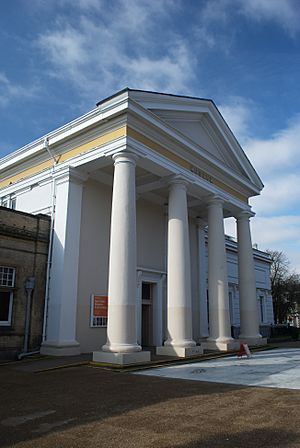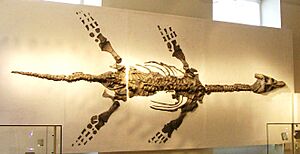- This page was last modified on 17 October 2025, at 10:18. Suggest an edit.
Leicester Museum & Art Gallery facts for kids
 |
|
| Former name | New Walk Museum |
|---|---|
| Established | 1849 |
| Location | New Walk, Leicester, England |
| Architect | Joseph Hansom |
| Owner | Leicester City Council |
| Nearest car park | On site (no charge) |
The Leicester Museum & Art Gallery is a super cool place to visit in Leicester, England. It's on New Walk, close to the city center. This museum first opened its doors way back in 1849. That makes it one of the very first public museums in the United Kingdom!
Inside, you'll find amazing displays about science, history, and art from all over the world and from Leicester itself. The first building was designed by Joseph Hansom, who also designed the famous hansom cab (a type of horse-drawn carriage). The museum has grown bigger over the years, with the latest expansion happening in 2011. Until 2020, it was known as the New Walk Museum and Art Gallery.
Contents
Explore the Museum's Amazing Collections
The museum has many exciting things to see all the time. These include huge dinosaurs, an Egyptian area, cool minerals from Leicestershire, and the very first Charnia fossil ever found nearby. There's also a "wildspace" area with stuffed animals from different parts of the world.
Dinosaurs and Fossils
The Leicester Museum & Art Gallery has a fantastic collection of ancient creatures that are no longer alive. You can see two large reptile skeletons from the Mesozoic Era (the time of dinosaurs) on display. One is a cetiosaur found in Rutland, and the other is a plesiosaur from Barrow upon Soar.
The Rutland Dinosaur, often called George, is a type of Cetiosaurus oxoniensis. This dinosaur is about 15 meters (50 feet) long! It's one of the most complete sauropod skeletons ever found anywhere. George was discovered in June 1968, in a quarry near Little Casterton in Rutland. The bones have been at the museum since 1975. Most of the bones you see on display are copies, because the real ones are too delicate.
The Barrow Kipper is a plesiosaur skeleton found in Barrow upon Soar in 1851. It got its nickname because it looks a bit like a flattened fish. Scientists have studied it a lot, and it's a very important fossil.
In September 2011, the museum made its Dinosaur Gallery even better. They rearranged the fossils, added a new room, and updated the whole area. The famous naturalist David Attenborough opened the new gallery. The main attractions in this gallery are the Rutland cetiosaur, the Charnia fossil, the plesiosaur, a Leedsichthys fossil (from a giant fish), and a piece of the Barwell Meteorite.
The museum also has a very special fossil called Charnia. This was the first fossil ever found that came from rocks older than the Cambrian period. Before this discovery, people thought large life forms didn't exist that early. The Charnia fossil at the museum is the actual example from which the species was first identified. Charnia masoni was named after Roger Mason, who found it in Charnwood Forest in 1957 when he was a schoolboy. The museum's display also mentions that a schoolgirl named Tina Negus found it a year earlier, but no one believed her at the time.
Ancient Egypt
The museum has a permanent exhibit all about Ancient Egypt. You can see four mummies there, named Pa-nesit-tawy, Pe-iuy, Bes-en-Mut, and Ta-Bes. Pe-iuy was the first mummy to join the museum's collection in 1859. Bes-en-Mut and Ta-Bes were brought from Egypt around 1880 by John Mason Cook, the son of Thomas Cook (who started the famous travel company). He later gave them to the museum.
Pa-nesit-tawy was the last mummy to be donated in 1928. He lived around 600 BC and was buried in Thebes. Many of the items in the Egyptology section came from Europeans who visited Egypt in the 1800s. The museum's Egyptian galleries were greatly expanded in 2018. The museum has over 400 objects from Ancient Egypt. The new gallery allows many more of these amazing items to be shown to the public. Since 2020, the gallery has also displayed a statue of a husband and wife, Sethmose and Isisnofret.
Other Cool Things to See
The museum has a stuffed polar bear named Peppy. Peppy is famous for being the mascot of Fox's Glacier Mints! You can find Peppy in a collection of taxidermy animals from all over the world. This exhibit includes animals from cold places, warm places, and even local areas.
The museum also has the largest collection of German Expressionist art in the UK. These paintings, by artists like George Grosz, Wassily Kandinsky, and Paul Klee, were secretly brought out of Nazi Germany before World War II. The Nazis did not like this type of art and called it "degenerate." Hans Hess, whose father was a German art collector, used to be an assistant curator at the museum.
In 2007, over 100 pieces of Picasso ceramic art were put on display. These were given to the museum by the famous actor Richard Attenborough.
Special Exhibitions
On the first floor of the museum, there is a special area for exhibitions that change regularly. Past exhibits have included displays about the search for the remains of King Richard III and a fun Wallace and Gromit display.
In the summer of 2019, a portrait of King Richard III was temporarily displayed. This was part of a project by the National Portrait Gallery, following the king's reburial in Leicester Cathedral in 2015.
New Name for the Museum
The museum reopened in August 2020 after being closed for a while due to the COVID-19 pandemic. When it reopened, it had a new name: Leicester Museum & Art Gallery. This new name was chosen to show that it is Leicester's main museum. It also helps people from outside the city find it more easily when searching online.

